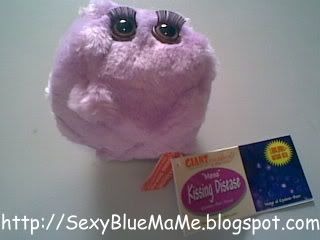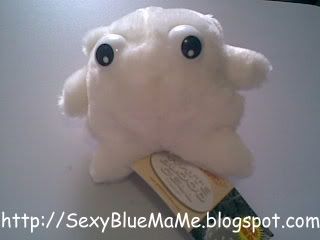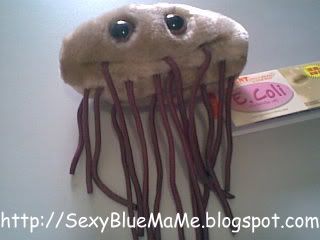
I spy with my 4 eyes (2 are mine while the other 2 are from my glasses) and see an orange box

And so, I decided to open it and see what's exactly inside. Yikes! Microbes, to be precise, it's Giant Microbes!!
And so, Pu Niao wasted no time in trying to figure out which cell is which and what functions do they have in our body exactly!!

Giant Microbes: Sore Throat (Streptococcus Pyogenes)
Streptococcus bacteria cause about 15 percent of sore throats; viruses cause most of the rest! It can be difficult to tell if your sore throat is being caused by strep or by a virus, but it is important to try. Viral sore throats can only be soothed with such remedie as lozenges, gurgling salt or vinegar, or drinking honey or peppermint tea. However, strep throats can be cured easily by taking antibiotics such as penicillin. Also, if strep throat is left untreated, it can develop into a more serious disease such as rheumatic fever, which can cause heart problems.
So, how can you tell the difference? Viral sore throats are often accompanied by symptoms such as a cough, runny nose, watery eyes, hoarseness and diarrhea. Strep throat symptoms include sudden fever, stomach aches and swollen glands. Strep is also much more common during the winter.
Even so, the only way to be certain is to get a throat culture. If you have a sore throat that lasts for several days, you probably should consult a physician.
Giant Microbes: Flu (Orthomyxovirus)
The flu, a.k.a. influenze, is a respiratory infection caused by strains of orthomyxoviridae. The word "influenze" comes from the Italian word for influence - back when the stars were thought to influence the start of an epidemic!
Every year 5% - 40% of the population gets the flu. Fortunately, most people recover completely in a couple of weeks. Even more fortunately, since there are only about a dozen different flu viruses, vaccines have been developed that can be up to 90% effective in preventing infection in the first place.
These vaccines, or "flu shots", are best taken in the fall before the flu season starts, since it can take several weeks for them to become fully effective However, since eggs are used to make the vaccines, people who are allergic to eggs should not get the shots.

Giant Microbes: "Mono" Kissing Disease (Epstein - Barr Virus)
The Kissing Disease, or mononucleosis, is caused by the Epstein - Barr Virus (named after its discoverers Michael Epstein and Y. M. Barr). More than 95% of the population is infected!
Most people catch the virus at a very young age, at which time the symptoms are often too mild to be noticed. However, those who catch it when they are young adults (or older) suffer from sore throats, swollen lymph glands and extreme malaise. In addition, the spleen can become enlarged - sports and strenuous activities must be avoided to prevent rupture.
Esptein-Barr virus also causes an increase in the level of "mononuclear" white blood cells in the blood, which is how the disease hot its nickname. Nevertheless, Epstein-Barr is not very contagious. Transmission requires close contact such as kissing or sharing drinks. And with an incubation period of 4-7 weeks, it can be a while before you know whether you've caught it.

Giant Microbes: Bad Breath (Porphyromonas Gingivalis)
Many people believed that bad breath, or halitosis, is caused by gas rising up form the stomach - particularly after eating onions or spicy foods. In fact, most cases are caused by microbes such as Porphyromonas gingivalis!
Between three and four hundred types of microbes typically call the human mouth home. Most are harmless. But a few produce "volatile sulfur compunds". These compounds, such as hydrogen sulfied - which smells like rotten eggs - give bad breath its characteristic odor.
Other oral bacteria by-products include cadaverine and putrescine, which are typical of rotting corpses and rotting meat! So what can you do about Porphyromonas gingivalis? Brush and floss, of course. Oh, and avoid onions and spicy foods: they're very high in sulfur content.

Giant Microbes: Stomach Ache (Shigella Dysenteriae)
A lot of stomach aches are caused by gas or acid in your stomach. But others are caused by microbes. Shigella is one of the more common culprits! It is particularly common in developing countries and is a major cause of traveler's diseases.
Shigella is named after a Japanese researcher named Shiga who discovered the bacterum in 1897. It causes an intestinal tract infection that produces abdominal cramps. fever and diarrhea.
Shigella is extremely contagious. In fact, it is so contagious that if even 10 individual bacteria get into your system, you can become infected! As a result, over 140 million people are infected by Shigella every year.
The most important step to take if you are infected is to stay hydrated - though antibiotics can be used against the bacteria in the more severe cases. Better yet, avoid infection in the first place by washing your hands a lot!

Giant Microbes: Common Cold (Rhinovirus)
There are over 250 different kinds of cold viruses! But rhinovirus is by far the most common. (Rhino means "nose" in Greek - think rhinoceros). With over 100 different varieties, rhinoviruses are responsible for almost 35 percent of colds.
Rhinovirus is particularly active during the fall and winter months. Why? Because rhinovirus loves the low humidity. Also, when the humidity is low, your nose dries out and is more susceptible to infection. But, despite what many think, studies show that one thing that doesn't cause a cold is cold!
The best thing you can do to lower your chances of catching a cold is to wash your hands a lot. Rhinovirus can survive three hours outside someone's nose. If it gets on your fingers and you rub your nose, you've caught it!

Giant Microbes: Cough (Bordetella Pertussis)
Coughs are very common and can be triggered by a variety of factors including smoking, allergies and even heartburn, as well as more serious conditions such as asthma, tuberculosis, congestive heart failure and lung cancer. But many coughs, particularly in young children, are caused by microbes.
While common cold and flu viruses can cause ordinary coughs, B. pertussis bacteria causes "whooping cough", a serious cough that can go on over 6 weeks. Coughing spells, up to 40 a day, can last over a minute and often end with a "whoop" of gasped air. While in older children and adults the risk are generally slight, small children can suffer oxygen deprivation and turn blue.

Giant Microbes: Red Blood Cell (Erythrocyte)
Red Blood Cells, or erythrocytes, contain the hemoglobin that carries oxygen and carbon dioxide around the body. Hemoglobin gives red blood cells their characteristic color. When it is oxygen-rich, it appears reddish; when oxygen-poor, it is darker and bluish.

Giant Microbes: Brain Cell (Neuron)
The little grey cells that make up your mind are primarily neurons. You have approximately 10 billion of them in your head!
The typical neuron is connected to thousands of others forming an inconceivably dense signal-processing network. With over a 1,000 trillion connections, or synapses, in your brain, there are more transmission-pathways in your head than there are atoms in the universe. But before you let that go to your head, think about this: the number of synapses peaks in early childhood, so the average three-year-old has ten times as many as the average adult!

Giant Microbes: White Blood Cell (Leukocyte)
White blood cells, or Leukocytes ("white cell" in Greek), are your body's white knights. If an enemy germ invades you, they ride to the rescue and fight to the death.
There are several different kinds of leukocytes, and each has special skills that help protect you. For example, neutrophils race to the scene when bacteria attack. They suffer large casualties creating the pus that forms on infections. B cells hurl antibodies at virulent viruses to neutralize them so T cells can move in for the kill. And when the dust finally settles, monocytes help clean up the place by digesting microorganisms and their remains.

Giant Microbes: E. Coli (Escherichia Coli)
The Escherichia coli bacterium was identified in 1885 by Austrian physician Theodor von Escherich. Its peritrichous flagella (the hairs which can sprout anywhere on its body) can twirl around propelling it forward at the bacteria-equivalent speed of a torpedo.
Many strains of E. coli are harmless, and huge numbers are present in the human and animal gut. In addition, E. coli is amongst the most studied of all creatures great and small. Not only is it ubiquitous, but it is simple to cultivate. Under ideal conditions it can divide every 20 minutes; a single cell can become over a billion in less than 10 hours!

Giant Microbes: Bunch of Microbes (BunchOfMicrobes)
Giant Microbes: Happy New Year!! *waves*
Red Blood Cell: Click the lion, it's red like me~ ~ ~
Pu Niao: Hey! That's supposed to be my line!!



they're the cutest germs i've ever seen! where are you keeping them?
ReplyDeleteWee I wish I could also have a bunch of those!
ReplyDeleteI know them! :D
Dear miss igorota,
ReplyDeletei'm keeping them inside the box (to prevent dust) and keeping them in my house. Glad you love this post too!!
Sincerely,
Pu Niao
Dear Bryan Karl,
ReplyDeleteyou can actually buy all these Giant Microbes at http://www.firebox.com
But be warned that there are even many more to be collected though. So, do take your time if you want to get these.
Sincerely,
Pu Niao
I've seen these on ThinkGeek.com! They're adorable, and I think they have the petri dish ones too ^.^
ReplyDeleteDear Mr Joan Croft,
ReplyDeleteDo note that before buying, you have to check the prices first. There are quite a lot of sites selling these and you wouldn't want to pay $10 when you can actually get them for $5 - $8 each though. I've actually came across a few sites that are selling the microbes for $10 per piece.
Sincerely,
Pu Niao